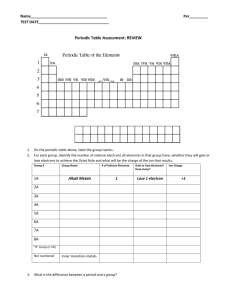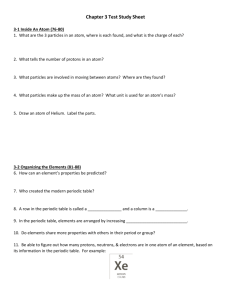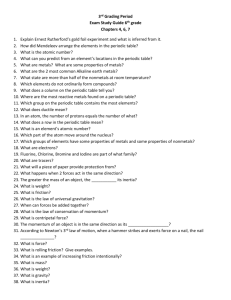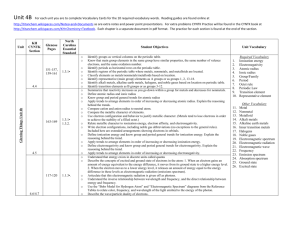ELECTRON ARRANGEMENT AND THE PERIODIC TABLE
advertisement
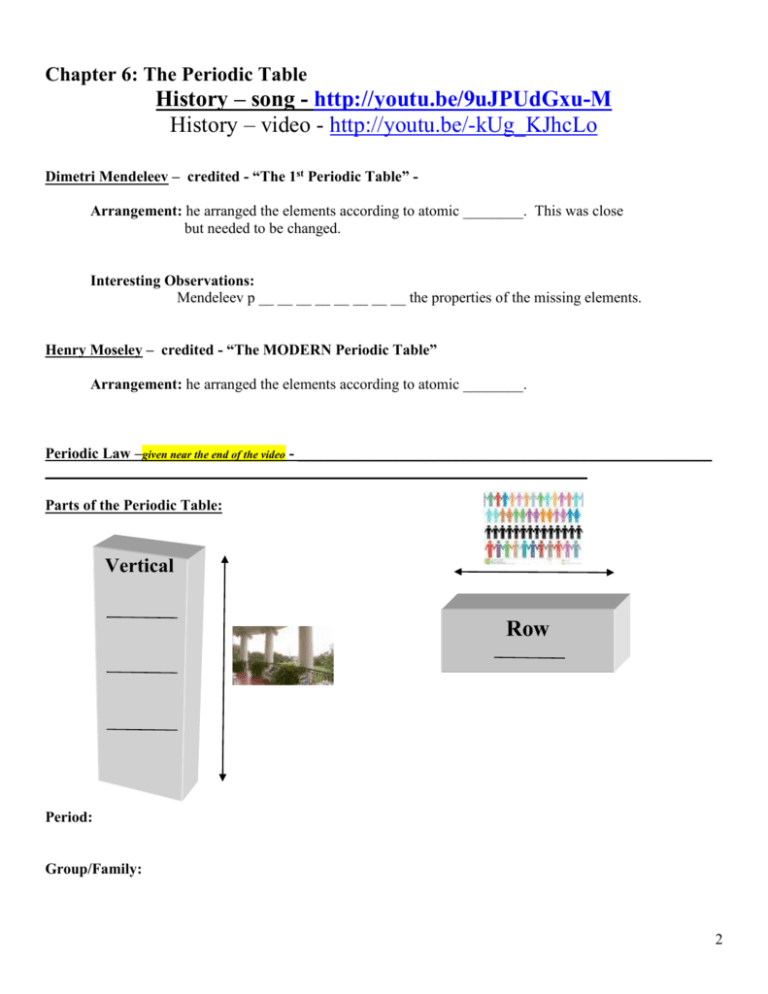
Chapter 6: The Periodic Table History – song - http://youtu.be/9uJPUdGxu-M History – video - http://youtu.be/-kUg_KJhcLo Dimetri Mendeleev – credited - “The 1st Periodic Table” Arrangement: he arranged the elements according to atomic ________. This was close but needed to be changed. Interesting Observations: Mendeleev p __ __ __ __ __ __ __ __ the properties of the missing elements. Henry Moseley – credited - “The MODERN Periodic Table” Arrangement: he arranged the elements according to atomic ________. Periodic Law –given near the end of the video - _______________________________________________________ ________________________________________________________________________ Parts of the Periodic Table: Vertical Row Period: Group/Family: 2 Tour of the Periodic Table: http://youtu.be/21RC2CDm9XQ Metals Non-Metals Metalloids NOTE: look Most elements are (metals / non-metals) (circle one) Group/ Family(copy from website) Name Reactivity Ion Formation Misc. Hydrogen Alkali Metals Alkaline Earth Metals Transition Metals Inner Transition Metals Halogens Noble Gases 3 Formation of Ions http://youtu.be/gsvR4AZGRSk (near the middle he meant to type 2+ but records 2- by mistake for Mg) video for anions (since the last one only focused on cations) - https://www.youtube.com/watch?v=WWc3k2723IM Octet Rule: Cations: Example: Mg vs. Mg2+ Mg Mg2+ Cl Cl- Bohr Diagram Electron Configuration Anions: Example: Cl vs. Cl- Bohr Diagram Electron Configuration 4 Periodic Trends http://youtu.be/K7ZdajBz4ak There is Big difference between what impacts a trend down a column and a trend across a row/period COLUMN Example: The shielding effect H 1s1 (how filled inner Li 2s1 levels shield the Na 3s1 valence e- (s) from K 4s1 the attraction to Rb 5s1 the nucleus) _0_ filled inner levels blocking the attraction between the nucleus and outer electron (H) __1__ filled inner level blocking the attraction between the nucleus and outer electron (Li) ____ filled inner levels blocking the attraction between the nucleus and outer electron (Na) Valence energy level is n=1 Valence energy level is n=2 Valence energy level is n=___ As you look down a column, the outermost principle energy level __________________. (but the number of valence e-‘s stays the same) (increases/ decreases) As more and more levels become filled with electrons, the nucleus becomes ___________ effective at attracting the outer electron(s). This is known as the “shielding effect.” (As you look down a column, even though the nucleus theoretically is stronger since it has more protons, it is NOT effective at holding onto the outer electrons.) Which energy level has NO shielding? ____________ Which atom holds onto the outer electron tighter, K or Rb? Why? _____ has one more filled level than ____ and therefore is _____ effective at holding onto the outermost (valence) electron. 5 Is the shielding effect an issue with a row?__NO!___ Row, Period , Series 1 level of shielding throughout entire row! What is the valence energy level being filled across this row Strength of nucleus n=2 n=2 n=2 n=2 n=2 __3__ ____ _____ _____ _____ n=2 n=2 n=2 _____ _____ __10___ The nucleus is getting stronger as you look to the right and this time it IS EFFECTIVE # of protons No element in the same row has any more energy levels filled than any other element. All the same! Which energy level is being filled across this row?________ How n=2 many energy levels are n=2filled when looking at row 2?_____. Amount of shielding does / does not change across a row. The energy level is not changing. What is changing? ________the strength of the nucleus ________ Is the nucleus getting stronger?_________. Is it effective?________ In a row, ___________ ___________(and not shielding) determines the trend. Recap: In a row, the nucleus gets stronger and _____ effective. In a column, the nucleus gets (is / is not) stronger and _____ effective. (is / is not) (both getting stronger but one way is effective and one way is NOT!) Column: the __________ _________ dictates the trends. Row: the increasing strength of the __________ dictates the trends. 6 PERIODIC TRENDS #1 ATOMIC RADIUS http://youtu.be/8dDVxqI_0I4 Measured using bond radius: ½ distance between nuclei of adjacent atoms. Down a Group: size of the atom increases / decreases. Reason: Across a Period: size of the atom increases / decreases. Reason: IONIC RADIUS The size of an ion as compared to the size of the atom depends if we are looking at a metal ion (cation/+) or a non-metal ion (anion/-) Metals tend to _________ electrons and become ____________ions. (gain or lose) positive or negative) ** (metal ions are ___________than metal atoms) (smaller or larger) Non- metals tend to _______ electrons and become __________ ions. (gain or lose) (positive or negative) ** (non-metal ions are ______________than non-metal atoms) (smaller or larger) Noble gases _________ gain or lose electrons. Mark the area in the periodic table where a. The most active metals are found with an X b. The most active non-metals are found with an Y http://youtu.be/yADrWdNTWEc mark the table with the common ions for each column 7 #2 IONIZATION ENERGY http://youtu.be/Mmti4kKDcqA Down a Group: increases / decreases. Reason: Across a Period: increases / decreases. Reason: Lower down in a column the atoms are larger / smaller and have more attractiveness / shielding so it is easier to remove an e- from the outer shell. It is harder/ easier to remove an electron from a small atom with no shielding. It gets harder/ easier to remove that electron as you move to the right as it approaches a perfect octet. Which column would be very difficult to go in and remove and electron from? _________ So the column with the highest Ionization Energy = _________ Which element has the least IE? the most IE? 8 #3 ELECTRONEGATIVITY http://youtu.be/5z54GfoBP0k Down a Group: increases / decreases. N o Reason: n o b l e Across a Period: increases / decreases. Reason: Fluorine atom pulls harder on the shared pair of electrons. They are shared “unevenly” Electronegativity of Fluorine is >,=,< the electronegativity of hydrogen Chlorine atoms share the pair of electrons “evenly” Electronegativity of Chlorine is >,=,< the electronegativity of Chlorine In water, does Hydrogen or Oxygen pull harder on the shared pair of electrons? ____________ Which column does NOT bond with any element (because it has a perfect octet)? ____________________ (No electronegativity values are assigned) 9 MOLECULE/MOLE/MASS CONVERSIONS FOR DIATOMIC ELEMENTS http://youtu.be/jpPNRNEnV5s (start at 1:32 Atomic mass: Average atomic mass of isotopes for an element (for example 1 mol C = 12.0 g/mol) Molecular mass: for a diatomic molecule it is twice the atomic mass (for example 1 mol Br2 = 159 g /mol) Diatomic Elements (BrINClHOF): elements that don’t exist as a single atom; elements bond in pairs (H N F O I Cl Br) Conversions: 1. Find the mass of 1.20 moles of bromine. 2. How many molecules are in 2.4 moles of nitrogen. 3. Find the mass of 4.5 x 1025 molecules of iodine. 4. How many molecules are in 15.0g of oxygen? 5. *** Find the mass of 0.25moles of radon. 6. ***How many atoms are in 4.0g of oxygen? 10 PRACTICE/HW PERIODIC TABLE VOCABULARY PART I: Vocabulary Review Match the correct vocabulary term to each numbered statement. Write the letter of the correct term on the line. Column A Column B 1. The highest occupied s and p sublevels are partially filled. a. representative elements 2. The highest occupied s sublevel and a nearby d sublevel contain electrons. b. electronegativity 3. metals having only 2 electrons in the highest occupied energy level c. atomic radius 4. one half the distance between the nuclei of two atoms of the same element when the atoms are joined d. metals 5. decreases for cations and anions from left to right across a period e. ionization energy 6. measures the ability of an atom to attract electrons when the atom is in a compound f. cation 7. an atom or group of atoms that has a positive or negative charge g. noble gases 8. elements in which the highest occupied s and p sublevels are filled h. alkali metals 9. nonmetals of Group 7A i. inner transition metals 10. The highest occupied s sublevel and a nearby f sublevel contain electrons. 11. energy required to remove an electron from an atom j. nonmetals k. ionic radius 12. positively charged ion 13. Group 1A elements l. ion 14. good conductors of heat and electric current m. Group 2A 15. negatively charged ion 16. poor conductors of heat and electric current n. transition metal o. halogens p. anion 11 CLASSIFYING THE ELEMENTS Part A Completion Use this completion exercise to check your understanding of the concepts and terms that are introduced in this section. Each blank can be completed with a term, short phrase, or number. The periodic table displays the symbols and _______ the 1 1. elements along with information about the structures of their 2. 2 3 _______. The Group 1A elements are called _______, and the 3. 4 Group 2A elements are called _______. The elements in Groups 4. 5 1A through 7A are called the _______. The nonmetals of Group 5. 6 7A are _______, and the _______ make up Group 8A. Between 7 6. 8 Groups 2A and 3A, there are _______in periods 4 through 7 and 7. _______ in periods 6 and 7. 9 8. The atoms of the noble gas elements have their highest 9. 10 occupied s and _______ sublevels filled. The highest occupied s 10. 11 and p sublevels of the representative elements are _______. 11. Part B True-False Classify each of these statements as always true, AT; sometimes true, ST; or never true, NT. _______ 12. Group A elements are representative elements. 13. Chlorine has the electron configuration 1s22s22p63s23p7. 14. The element in Group 4A, period 3, is gallium. 15. There is a relationship between the electron configurations of elements and their chemical and physical properties. Part C Matching Column A Column B 16. alkali metals a. nonmetals of Group 7A 17. inner transition metal b. an element in which the highest occupied s and p sublevels are filled 18. representative element c. Group 2A elements 19. transition metal 20. noble gas d. an element whose highest occupied s sublevel and a nearby d sublevel contain electrons 21. alkaline earth metals 22. halogens e. an element whose highest occupied s sublevel and a nearby f sublevel generally contain electrons f. Group 1A elements g. an element whose highest occupied s or p sublevels are partially filled 12 13 Periodic Table: Fill in the blanks. 1. Where are the most active metals located? _________________________________ 2. Where are the most active nonmetals located? ______________________________ 3. A negative ion is ( larger / smaller ) than its parent atom. 4. A positive ion is ( larger / smaller ) than its parent atom. 5. Elements of Group 1A are called ________________________________________ 6. Elements of Group 2A are called ________________________________________ 7. Group 7A elements are called __________________________________________ 8. The most active element in group 7A is ___________________________________ 9. Group 8A elements are called __________________________________________ 10. Elements in the “B” groups are called ___________________________________ 11. As you go from left to right across the periodic table, the elements go from ( metals / nonmetals ) to ( metals / nonmetals ). 12. What sublevels are filling across the transition elements? ____________________ 13. Elements within a group have a similar number of __________________________ 14. Elements in the same period have the same number of _______________________ 15. The majority of elements in the periodic table are ( metals / nonmetals ). 16. Elements in the periodic table are arranged according to their __________________ 17. An element with both metallic and nometallic properties is called a ______________ 18. Metals form ( positive / negative ) ions. 19. Nonmetals form ( positive / negative ) ions. 20. An atom or ion is most stable when it has ________ valence electrons. 21. Another word for a positive ion is __________________ 22. Another word for a negative ion is __________________ 23. The most stable and unreactive elements are the _______________________ 24. Classify the following properties as metallic (m) or nonmetallic (nm): Luster ______________ malleable ______________ Conducts electricity __________ Ductile _____________ found in all 3 states of matter ___________ conducts heat ___________ Found mostly as solids ____________ insulators _______________ 14 Periodic Table For each of the following, circle the correct element. Li Si S metal K Ca Sc largest atomic mass S Cl Ar member of the halogen family V Nb Ta largest atomic number Te I Xe member of noble gases Si Ge B member of alkali metals As Se Br 6 valence electrons H Li Na nonmetal Hg Tl Pb member of transition metals Na Mg Al electron distribution ending s2p1 Pb Bi Po metalloid B C N gas at room temperature Ca Sc Ti electron distribution ending in s2d2 K S Ba has an electron dot like: X: U Zn Kr member of inner transition metals Ca S Br forms a +2 ion F Na Mg member of the alkaline earth metals Al Cr P 3 valence electrons Rb I Al forms a -1 ion H He O a gas that is not reactive 15 PERIODIC TRENDS 1. Circle the member of each pair that has the greatest radius: a. nitrogen or arsenic (As) b. calcium (Ca) or zinc (Zn) c. manganese (Mn) or technetium (Tc) d. iodine (I) or rubidium (Rb) e. boron (B) or neon f. krypton (Kr) or neon (Ne) 2. Arrange the elements below in order of increasing radius: Cesium (Cs), Potassium, Bromine, Selenium (Se) 3. Circle the member of each pair that has the greatest ionization energy: a. nitrogen or arsenic (As) b. calcium (Ca) or zinc (Zn) c. manganese (Mn) or technetium (Tc) d. iodine (I) or rubidium (Rb) e. boron (B) or neon f. krypton (Kr) or neon (Ne) 4. Arrange the elements below in order of increasing ionization energy: Cesium (Cs), Potassium, Bromine, Selenium (Se) 5. Select the member of each pair that has a greater electronegativity: a. nitrogen or arsenic (As) b. calcium (Ca) or zinc (Zn) c. manganese (Mn) or technetium (Tc) d. iodine (I) or rubidium (Rb) e. boron (B) or neon f. krypton (Kr) or neon (Ne) 16 SECTION 6.1 ORGANIZING THE ELEMENTS 1. Which element listed below should have chemical properties similar to fluorine (F)? a. Li b. Si c. Br d. Ne 2. Identify each element as a metal, metalloid, or nonmetal. a. fluorine b. germanium c. zinc d. phosphorus e. lithium 3. Which of the following is not a transition metal? a. magnesium b. titanium c. chromium d. mercury 4. Name two elements that have properties similar to those of the element potassium. 5. Elements in the periodic table can be divided into three broad classes based on their general characteristics. What are these classes and how do they differ? SECTION 6.2 CLASSIFYING THE ELEMENTS 1. Use the periodic table to write the electron configuration for silicon. Explain your thinking. 2. Use the periodic table to write the electron configuration for iodine. Explain your thinking. 3. Which group of elements is characterized by an s2p3 configuration? 4. Name the element that matches the following description. a. one that has 5 electrons in the third energy level b. one with an electron configuration that ends in 4s24p5 c. the Group 6A element in period 4 5. Identify the elements that have electron configurations that end as follows. a. 2s22p4 b. 4s2 c. 3d104s2 6. What is the common characteristic of the electron configurations of the elements Ne and Ar? In which group would you find them? 7. Why would you expect lithium (Li) and sulfur (S) to have different chemical and physical properties? 8. What characterizes the electron configurations of transition metals such as silver (Ag) and iron (Fe)? 17 SECTION 6.3 PERIODIC TRENDS 1. Explain why a magnesium atom is smaller than atoms of both sodium and calcium. 2. Predict the size of the astatine (At) atom compared to that of tellurium (Te). Explain your prediction. 3. Would you expect a Cl– ion to be larger or smaller than an Mg2+ ion? Explain. 4. Which effect on atomic size is more significant, an increase in nuclear charge across a period or an increase in occupied energy levels within a group? Explain. 5. Explain why the sulfide ion (S2–) is larger than the chloride ion (Cl–). 6. Compare the first ionization energy of sodium to that of potassium. 7. Compare the first ionization energy lithium to that of beryllium. 8. Is the electronegativity of barium larger or smaller than that of strontium? Explain. 9. What is the most likely ion for magnesium to form? Explain. 10. Arrange oxygen, fluorine, and sulfur in order of increasing electro negativity. Arrange the following from smallest to largest in size (atomic and ionic radius). a. N-3, N _________ < ___________ b. Mg2+, Mg _________ < ___________ c. Li, Li+1, Be+2 _________ < ___________ < _________ d. F, F-1, O-2 _________ < ___________ 18 PRACTICE MOLE CONVERSIONS: 1. List the diatomic elements: ____________ ____________ ____________ ____________ ____________ ____________ ___________ 2. Find the mass of: a. 3.0 moles of oxygen _____________ b. 1.15 moles of chlorine _____________ c. 0.35 moles of argon ______________ d. 1.14 x 1026 molecules of bromine ______________ e. 2.55 x 1022 atoms of barium ______________ 3. Convert to moles: a. 4.0g of hydrogen b. 7.68 x 1024 molecules of iodine 4. Find the number of molecules in: a. 16.0g of chlorine b. 2.5 moles of nitrogen ***5. How many atoms are in 4.0g of fluorine? _______________ _______________ _______________ _______________ ______________ 19 Colored PeriodicTable Instructions: 1. First number each group from left to right (1-18). See the big periodic table at the front of the room. 2. Second, number each period from top to bottom (1-7) . 3. Draw in the stepladder separating metals and nonmetals. Label metals vs. nonmetals on the table. Describe the properties of each group. 4. Create a color coded key for each of the following families or series of elements, or include the information within the colored block: Include a description of the properties of each group or block of elements. Alkali Metal Family (***don’t include hydrogen) Alkaline Earth Metal Family Halogens Nobel Gases Transition Metals Inner Transition Metals Metalloids +1 +2 -1 5. Write the ionic charge of the family (shown above) at the top of the column. Copy additional charges from the board. 6. Indicate the trends down and across for each of the following properties using arrows: Atomic Radii Ionization Energy Electronegativity 7. Identify fluorine as the most reactive non-metal 8. Identify francium as being in the spot for the most reactive metal 9. Label the diatomic elements: H2, N2, O2, F2, Cl2, Br2, I2 10. Label Al3+, Zn2+, Ag+1 20


